Rubber plants seem like they would be difficult to care for, but they’re actually very easy. You can grow them outside as a large tree or shrub, and they also make a wonderful indoor plant.
In this detailed guide I’ll show you all you need to know about how to care for Ficus elastica, so you can enjoy your rubber plant for many years to come.
I’ve included everything from watering and sunlight, to soil, pruning, repotting, fertilizing, pest control, propagation, troubleshooting common problems, and much more.
Quick Rubber Plant Care Overview
| Scientific name: | Ficus elastica |
| Classification: | Tropical plant |
| Common names: | Rubber Plant, Rubber Tree |
| Hardiness: | Zones 10+ |
| Temperature: | 65-85°F |
| Flowers: | N/A |
| Light: | Partial shade, bright light indoors |
| Water: | Keep soil evenly moist, do not overwater |
| Humidity: | Average to high |
| Fertilizer: | General purpose plant food spring-summer |
| Soil: | Fast-draining, fertile soil |
| Common pests: | Aphids, spider mites, mealybugs |
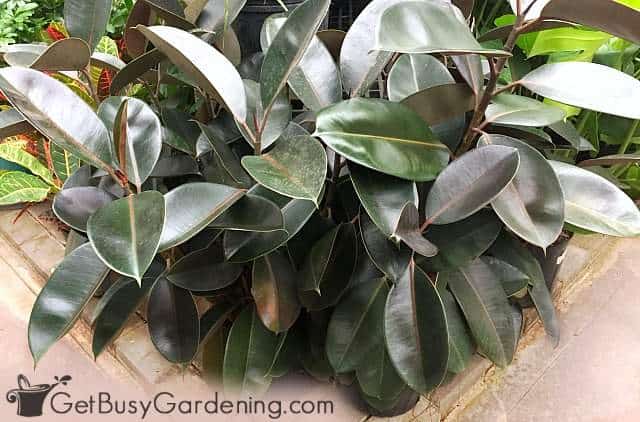
Information About Rubber Plants
The rubber plant (Ficus elastica, aka: rubber tree) is a member of the Ficus genus, which includes many other popular plants, like the fiddle leaf fig and weeping fig.
Native to India and Southeast Asia, rubber plants can grow to be over 50′ tall trees in the tropical rainforest.
As a houseplant, they stay relatively small by comparison. But they can still become quite large indoors, and will continue to grow as you move them into bigger containers.
Types Of Rubber Plants
There are several types of rubber tree plants that you can choose from, and they all require the same care. These days, there are cultivars that have even more beautiful foliage than the native form.
There are also dwarf versions, which are smaller and more compact. The variegated varieties are especially striking when you place them next to the ones with solid-colored leaves. Here are a few of my favorites:
- Ruby – The leaves have pink veins and stems with bright red edges against dark bronze-green centers.
- Lemon Lime – This variegated variety has yellow edges with green centers and red stems.
- Black Burgundy – The leaves on this one are such a dark burgundy color that they can appear almost black.
- Tricolor – The stunning foliage has brilliant orange, pink, and cream-colored variegation.
Related Post: How To Grow Plants Indoors: The Ultimate Guide
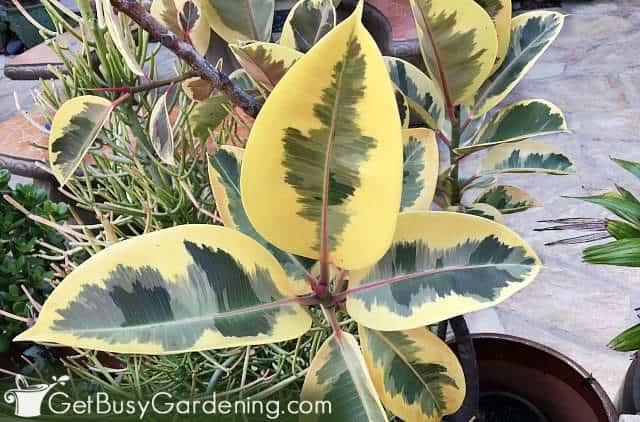
Rubber Plant Benefits
Not only are rubber trees very easy to grow, they have other benefits too. Just as the name suggests, the sap from the plant can be used for making rubber.
It’s also an excellent natural air purifying houseplant. In a list compiled by NASA, this one was found to have the highest capability to clean toxins out of the air than any other indoor plant.
Toxicity
Rubber plants are toxic to pets (see the ASPCA plant list for more information), and the sap can cause skin irritation.
So if you have cats, dogs, or small children around, then it’s best to keep this one out of reach. And always wash your hands after pruning or taking cuttings.
How To Grow Rubber Plants
Before we get into the details of rubber plant care, it’s important to understand a few things about how to grow them. The first step for success is to choose the best environment. Here’s how to figure it out:
Hardiness
Even though they are commonly sold as houseplants, rubber plants are actually tender evergreen perennial trees. They can live outside year round in zones 10 or higher.
Though they are hardy down to 35°F, they prefer warmer temperatures. So, if you live in a colder climate, be sure to bring yours back indoors before it gets below 50°F outside, or it may suffer from the transition.
Where To Grow Rubber Plants
Most people will have the best success growing rubber trees as indoor houseplants. They do best in a container that has drainage.
But you can put them outside during the summer to bask in the humidity and warmth. Just be sure to keep them out of the full sun.
They make excellent patio plants, and you can even grow them in your annual garden if you don’t want to bring them indoors.
If you do live in a warm enough climate, plant them in your garden in a location that has fast draining soil. And be sure to give them plenty of room to grow, they are trees after all.

Rubber Plant Care & Growing Instructions
Now that you know where to grow your rubber tree plant, let’s talk about the details of their care. Follow these tips for the best success:
Watering
The biggest mistake people make with growing rubber plants is overwatering them. However, they do not like to dry out completely either.
It’s best to water them evenly and consistently, especially during the summer. Allow the soil to dry 2″ deep between drinks, it should never feel overly wet or soggy.
An inexpensive moisture probe makes it simple to give your plant the perfect amount of water, keep the gauge reading between 3-5.
Light Requirements
Outside, rubber trees grow best in partial shade or dappled sunlight. They can handle more direct exposure in cooler climates. But it’s best to keep them out of the full sun in hot, dry regions, or the leaves could burn.
As an indoor plant, they enjoy a spot near a south-facing window with plenty of bright, indirect light. They don’t like it too hot, so be sure to move yours out of the sunny window during the summer.
Though they can adjust to lower light conditions indoors, rubber plants will become leggy if it’s too dark. If that starts to happen with yours, then move it to a brighter spot, or add grow light.
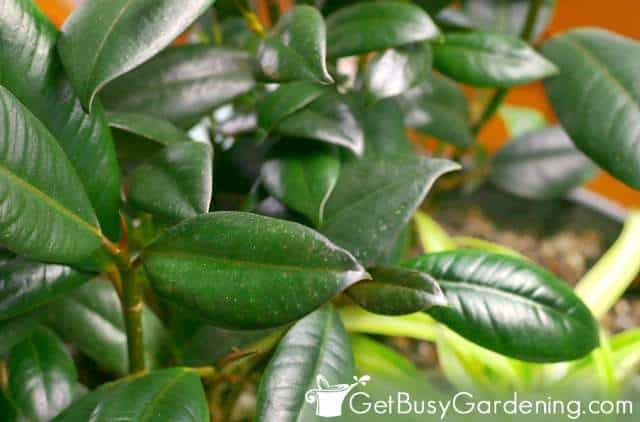
Fertilizer
Part of what makes a rubber plant so easy to care for is that they aren’t heavy feeders. So you don’t have to worry about giving them the perfect amount of fertilizer.
Start feeding in early spring to stimulate new growth, and continue through the summer. Apply a water-soluble fertilizer once a month. A general purpose one or a compost tea both work great.
Otherwise you could add slow-release granules a few times during the growing season, if you prefer. Just be sure to stop fertilizing in late summer, and do not feed your plant during the fall and winter.
Repotting
Rubber trees enjoy being a little pot-bound, which means that they like to have their roots crowded within the container. However, keeping them in the same pot for too long will stunt their growth.
So, if you want your plant to get larger, it’s a good idea to repot it once it has outgrown the container. Choose a pot that’s one or two sizes larger, and make sure it has drainage holes in the bottom.
They don’t love to be repotted though, so don’t do it unless it’s absolutely necessary. And do not be surprised if your rubber plant looks wilted for a couple of days or weeks afterward, just maintain the same care.
Soil
Choosing the best soil for rubber plants is pretty simple. Just purchase a standard potting mix that allows for good drainage.
Rubber trees are very tolerant to a wide variety of soil conditions. However it does need to be well draining to prevent root rot.
So, if you tend to overwater, or the soil holds too much moisture, then add some perlite or pumice into the mix to improve drainage.
Cleaning
Due to their large surface area, the leaves can become dusty and dirty pretty quickly. This not only looks bad, but it can also inhibit healthy growth.
So it’s important to clean them as a part of your regular rubber plant care routine. You can simply use a damp cloth to gently wipe the leaves.
Do not use waxes or leaf polishes though. These products can clog the pores and restrict proper air exchange.
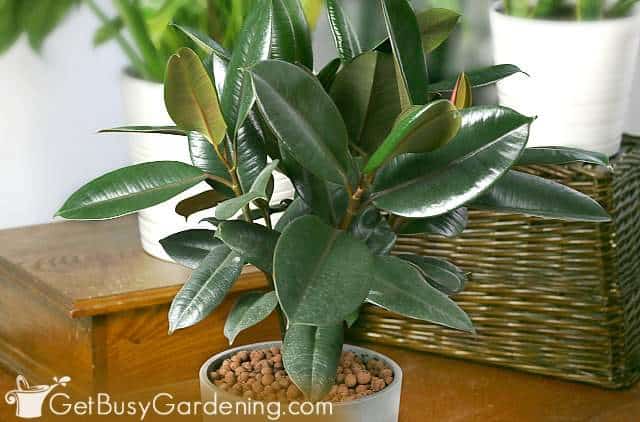
Pest Control
Pests aren’t usually a significant problem, especially when you care for your rubber plant properly. But sometimes aphids, spider mites, or mealybugs can attack them.
If yours becomes infested, you can gently wash the leaves with an organic insecticidal soap (or make your own using 1 teaspoon mild liquid soap to 1 liter of water).
For a stubborn infestation, I recommend using neem oil. Learn more about how to get rid of bugs on your plants here.
Pruning
To make a rubber plant bushy and maintain the size and shape, you can prune it regularly. The best time to do it is in the spring or summer, but you can remove dead or dying leaves at any time.
Always use sharp pruners to avoid damaging the stem. Be careful though, it can be a bit messy, since the white sap will drip out of the wounds. So indoors you may want to lay a towel under the plant to protect the floor.
Also, it’s a good idea to wear gloves and eye protection, since the sap can be a skin irritant – and you definitely don’t want to get it in your eyes.
Rubber Plant Propagation Tips
It’s pretty easy to propagate rubber plant. Take stem cuttings that are several inches long and have a few leaf nodes on them.
Remove the lower leaves and dip the stems into rooting hormone before putting it into a pot filled with moist soil. You could also try rooting them in water.
Either way, keep them in a bright, warm location and watch for roots. They should begin forming in 3-4 weeks. Wait until the roots are 3-4″ long before potting them up.
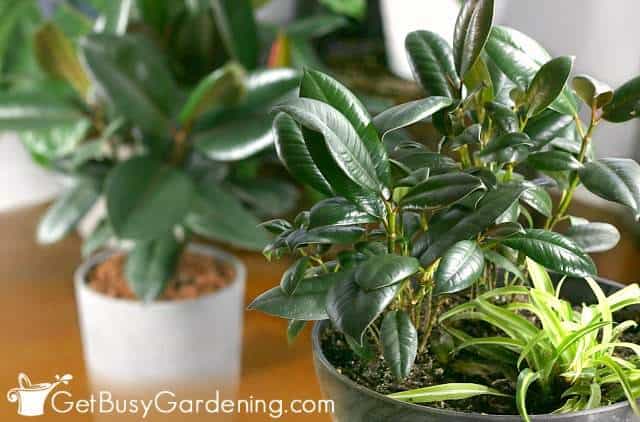
Troubleshooting Rubber Plant Care Problems
The most frustrating part about rubber plant care is when your baby becomes sick, and you don’t know why. To help you troubleshoot, here are some common problems, and the solutions.
Leaves Dropping Off
When the leaves drop or fall off of your rubber tree plant, it’s usually from overwatering. But it can also happen from under watering, low humidity, or bugs.
Ensure the soil is not wet or bone dry, and inspect the leaves for pests. Indoors, mist them regularly or use a humidifier if the air is too dry.
Drooping Leaves
When a rubber tree droops or wilts, that usually means it’s not getting enough water. But it could be from transplant shock, which is normal.
Ensure the soil stays consistently moist, and never becomes bone dry. If it’s from repotting, leave your plant where it is and maintain proper soil moisture until it recovers.
Leggy Rubber Plant
If they don’t get enough light, rubber trees will grow tall and leggy. To keep your plant bushy, move it to a brighter location or add a grow light indoors, or relocate it to a sunnier spot outside.
Prune off the leggy growth to encourage branching, and trim it on a regular basis to keep it compact and full.
Yellow Leaves
Yellowing is almost always caused by overwatering, but it could also be a sign that your rubber plant needs to be repotted into a larger container.
Allow the soil to dry 2″ deep between waterings. If it’s completely pot-bound, move it to a larger container.
Brown Leaves
When the leaves turn brown, it’s usually caused by either over or under watering. In some cases, it could be due to sunburn, or extreme hot or cold temperatures.
If the leaves start to fade, turn white, or look like they’re burning, then it’s probably getting too much sun. Move it to a spot where it will get indirect bright light. Always check the soil to make sure you’re watering properly.
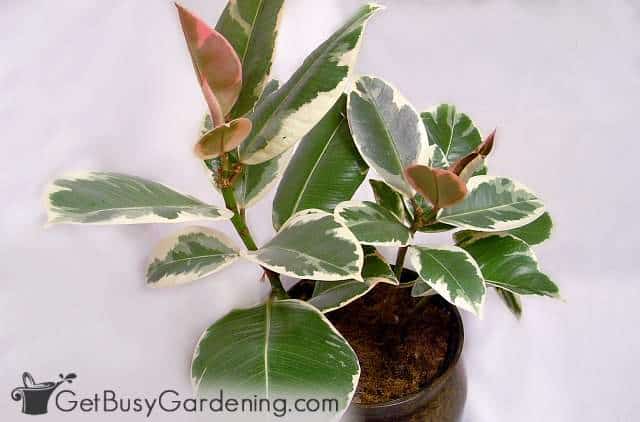
FAQs
Yes, when given the proper care, rubber plants are very fast-growing. They can grow a foot or more each year.
Spring is the best time for repotting rubber tree plants. But only repot it when it has become root-bound, and is no longer growing larger. They don’t love to be repotted, and usually wilt for several days afterward.
Yes, you absolutely can grow your rubber plant outdoors, they are hardy in zones 10+. In cooler areas, bring them back indoors before freezing temperatures arrive in the fall. You can even plant them in your garden if you live somewhere warm enough.
Rubber plant care isn’t difficult once you get the hang of it. With relatively minimal maintenance, you will be able to enjoy this large plant as a striking addition to your indoor home decor, or outside as a tree in your garden.
If you want to learn all there is to know about maintaining healthy indoor plants, then you need my Houseplant Care eBook. It will show you everything you need to know about how to keep every plant in your home thriving. Download your copy now!
Share your rubber plant care tips in the comments section below.
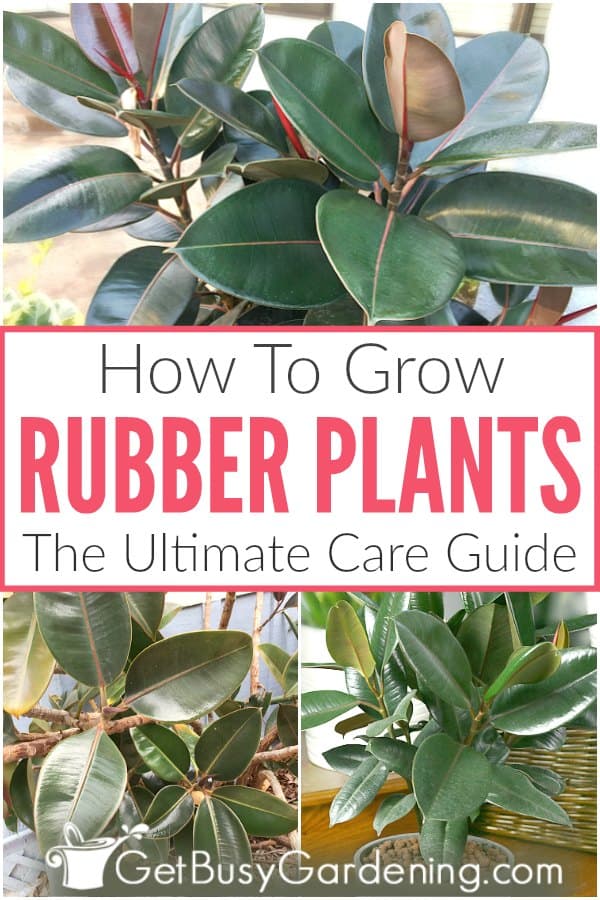

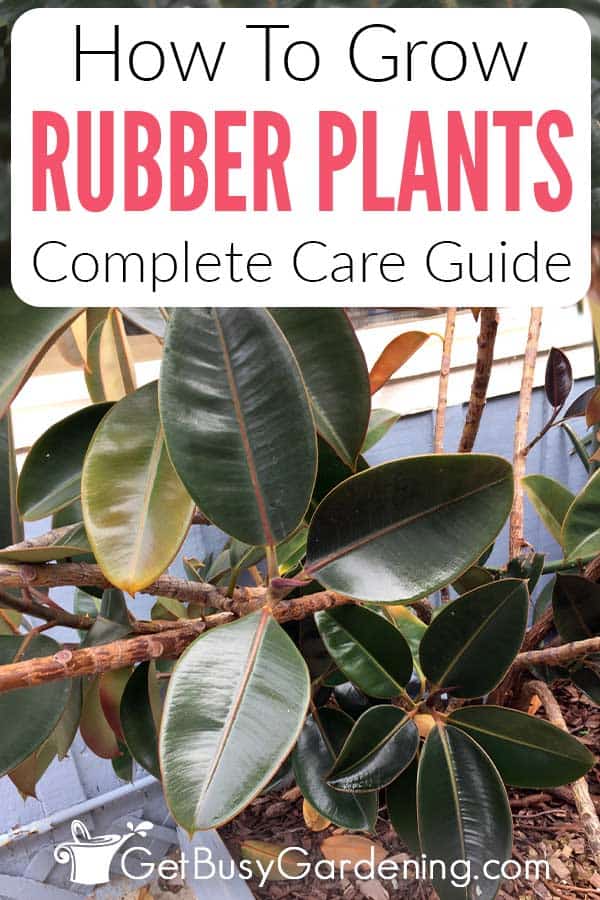
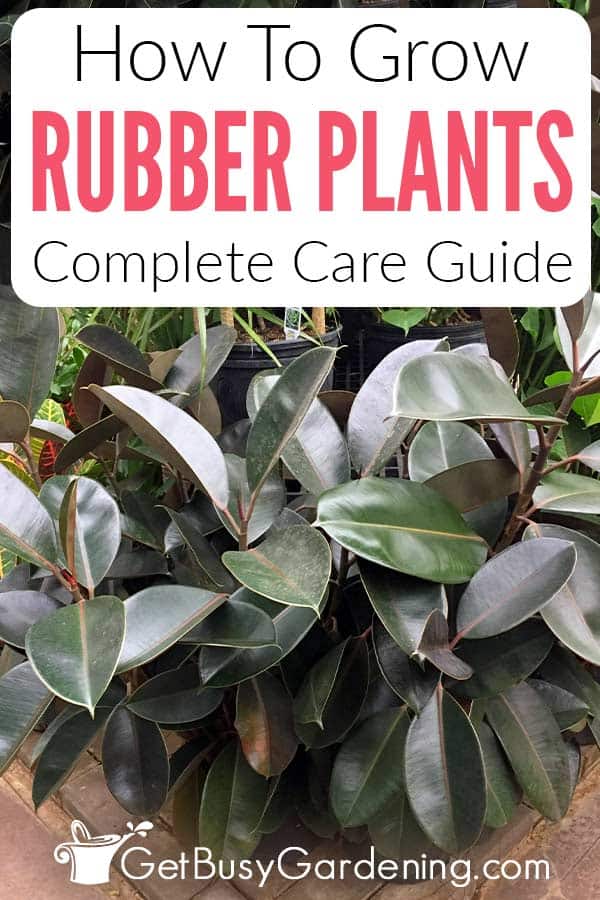
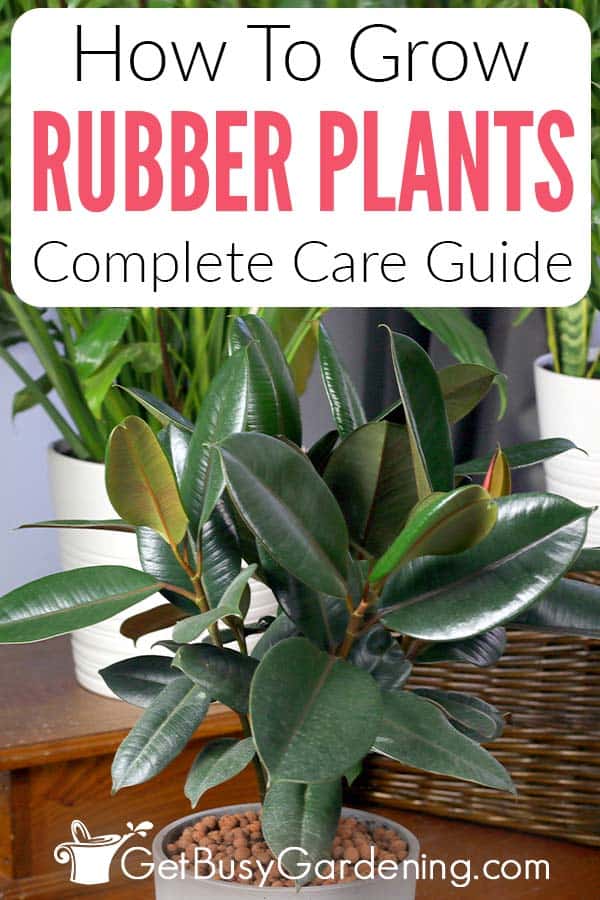
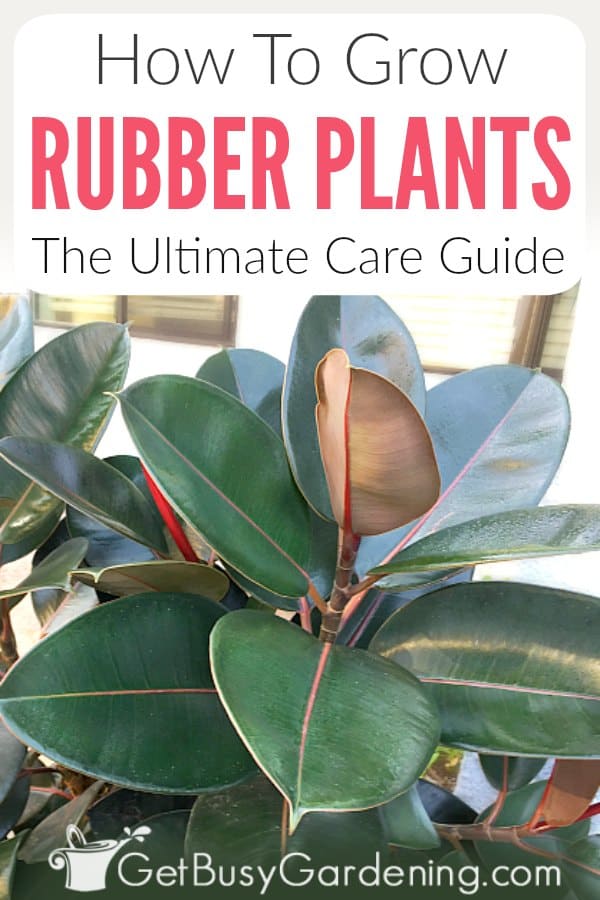
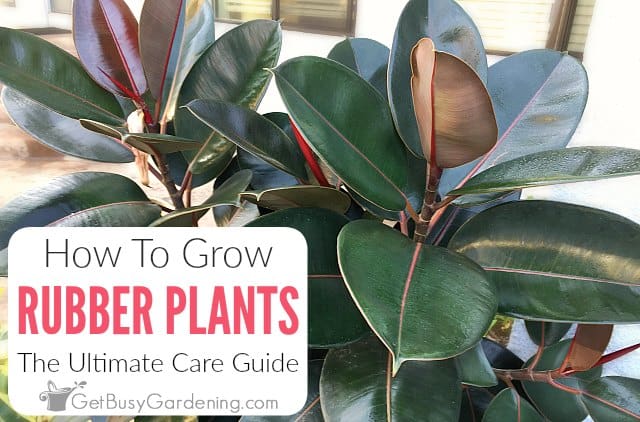



Joanna Smith says
Hi. My 3 yr old grandson emptied a bottle of oil for the hair into my rubber tree plant. Is there any way to save it or will I lose it eventually.
Amy Andrychowicz says
I guess it depends on the type of oil he poured into the soil. I really can’t say whether or not it will effect your rubber plant or not. If you’re concerned, then I would try repotting it and removing as much of the oil-soaked soil from the roots as you can.
maria jaramillo says
my rubber plant has grown too tall. can I trim it down some?
Amy Andrychowicz says
Yes, you sure can prune your rubber plant to maintain its size. See the “pruning” section in the post above for details.
Tehmina says
My rubber plant new leaves are really small and and really thin ,they are same as pear tree leaves,what shall I do
Amy Andrychowicz says
Most likely the small leaves on your rubber plant are caused by lack of light. But it could be caused by overwatering or a bug infestation. So be sure to inspect the leaves for signs of tiny insects.
Amy says
My plant has white spots on several of the leaves. The spots look like mold and are top of the leaf and not part of it. I have it in a south facing window in central California and it seems to be happy there and growing several new leaves since I got it in October. I am watering and rotating it every week. Any suggestions on what to do with the spots?
Amy Andrychowicz says
The white “mold” on your rubber plant could be mealybugs. Though they are bugs, they don’t look like it. They look like fuzzy white cotton, and many people mistaken them for mold on their plants leaves. Take a closer look, and see if that could be the problem. Here’s how to identify and get rid of them… How To Get Rid Of Mealybugs On Your Houseplants.
Brigitte F. says
Last year I moved my variegated rubber tree into the living room, and it must have been too warm. I had repotted it into a large 18″ square clay pot in the autumn, but it dropped all its leaves by the time spring came around. I kept it watered, and was careful not to overwater it. (I hope I wasn’t under watering it.) I’ve had this tree for at least 8 years and never had a problem.
Amy Andrychowicz says
Oh bummer!! Sorry to hear that your rubber plant is not doing well. Leaf drop could be caused by several things. Overwatering, under watering, lack of humidity, change in lighting, hot or cold drafts, or extreme temperature shifts. Since you moved it and also repotted it, that could have been the cause – too much change in a short period of time.
But you also mentioned that you may not be watering it enough, which could also be the problem. The best way to water a rubber plant is to allow the soil to dry (stick your finger down at least 1” to check for moisture), then give it a good, deep soaking (until water starts running out of the drainage holes). Make sure all the water drains from the pot, and dump the extra out of the drip tray. Also, compare its new location to the old one to see what is different. Like I said, temperature, humidity and lighting can all play a role. Good luck, I hope it will recover for you!